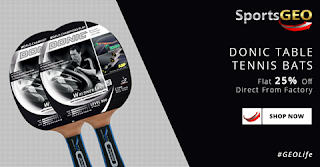About Tennis Racket
Tennis Racket is generally made of different types
of Materials. Most commonly used materials are Graphite, Aluminum, Boron and
Kevlar or the Wood. The vast majority of rackets manufactured today use graphite
in one form or another as the base ingredient. Graphite is the technological
generation’s equivalent of the trusty laminated wooden racket that was so
popular until about the 1970s. Graphite is remarkably strong for its relative
light weight. It provides terrific power, as well as good control and feel for
the ball. But graphite is best in a composite mixture with any of the various
thermoplastic and
Fiberglass type resins used today.
 Boron and Kevlar are the two fibers resemble
graphite, but boron and Kevlar are even lighter and stiffer than graphite.
These materials are strong, enabling you to hit with a lot of power. But unless
they are mixed with other materials, their stiffness can transmit a lot of
shock and vibration to your arm and shoulder, especially if you don’t hit the
ball on the sweet spot. Beginners should stay away from these materials. They make
sense only for strong players with a lot of experience in tennis.
Boron and Kevlar are the two fibers resemble
graphite, but boron and Kevlar are even lighter and stiffer than graphite.
These materials are strong, enabling you to hit with a lot of power. But unless
they are mixed with other materials, their stiffness can transmit a lot of
shock and vibration to your arm and shoulder, especially if you don’t hit the
ball on the sweet spot. Beginners should stay away from these materials. They make
sense only for strong players with a lot of experience in tennis.
Aluminum offers decent power and a surprising amount
of feel. Feel is the sensation you get for how you are striking the ball and
where it’s going. Some racket materials are more sensitive than others to
things like impact and vibration, so they transmit
information about them more readily.
Recently, a clutch of new rackets made from a very
strong, extremely light material called titanium have hit the market. Titanium
is similar to aluminum. Either aluminum or titanium is an acceptable choice for
beginners.
Many people still have wood or fiberglass rackets. You
can use these rackets, but doing so won’t help your game any. All those rackets
feature the obsolete, standard-sized heads. Also, when you buy new racket, you should
get the racket restrung, which means that you don’t end up saving any money.
Old strings are so brittle that they are sure to break soon after you start
playing with them. And if they don’t, old, dead strings may make you swing so
hard just to get the ball over the net that you could hurt your arm in the
effort.
The frame of the racket shall not exceed 29 inches
(73.66 cm) in overall length, including the handle. The frame of the Tennis racket
shall not exceed 12.5 inches (31.75 cm) in overall width. The hitting surface
shall not exceed 15.5 inches (39.37 cm) in overall length, and 11.5 inches
(29.21 cm) in overall width.
The frame, including the handle, shall be free of
attached objects and devices other than those utilized solely and specifically
to limit or prevent wear and tear or vibration, or to distribute weight. Any
objects and devices must be reasonable in size and placement for such purposes.
The frame, including the handle and the strings, shall be free of any device which
makes it possible to change materially the shape of the racket, or to change
the weight distribution in the direction of the longitudinal axis of the racket
which would alter the swing moment of inertia, or to deliberately change any
physical property which may affect the performance of the racket during the
playing of a point. No energy source that in any way changes or affects the playing
characteristics of a racket may be built into or attached to a racket.
The hitting surface of the racket shall be flat and
consist of a pattern of crossed strings connected to a frame and alternately
interlaced or bonded where they cross and the stringing pattern shall be
generally uniform, and in particular not less dense in the centre than in any
other area. The racket shall be designed and strung such that the playing
characteristics are identical on both faces.
The strings shall be free of attached objects and
protrusions other than those utilized solely and specifically to limit or
prevent wear and tear or vibration, and which are reasonable in size and
placement for such purposes. Always remember that there can’t be more than one
set of strings on the hitting surface of racket.


Comments
Post a Comment